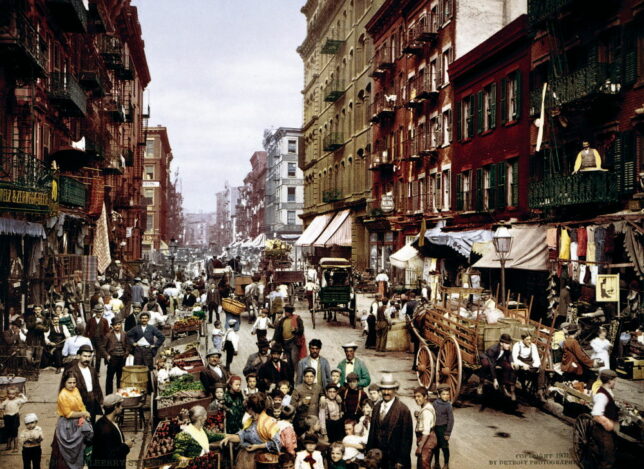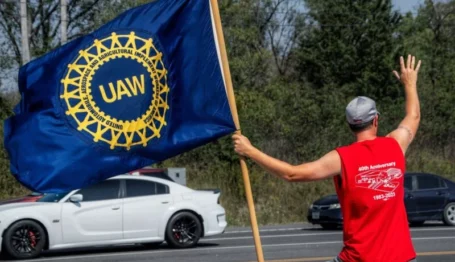Labor Watch
Creation of the Labor-Progressive Alliance: Industrialization and Labor Unionism
 After the Civil War concluded in 1865, industrialization came to define the American economy. Millions moved from the farms to the cities seeking employment in factories. Millions more came from overseas to toil for a share of the “American Dream.” Credit: Wallpaper Flare. License: https://bit.ly/3z5lUZz.
After the Civil War concluded in 1865, industrialization came to define the American economy. Millions moved from the farms to the cities seeking employment in factories. Millions more came from overseas to toil for a share of the “American Dream.” Credit: Wallpaper Flare. License: https://bit.ly/3z5lUZz.

Creation of the Labor-Progressive Alliance (full series)
Industrialization and Labor Unionism | Why Unions Came to Be
Defining the Workforce | Never Let a Crisis Go to Waste
Summary: The ties that bind organized labor to the left-of-center infrastructure, the Democratic Party, and the modern expansionist administrative state date predate the Wagner Act of 1935, which inaugurated the modern regime of private-sector labor-management relations. While early labor movements operated outside the major party system, by the Progressive Era and the administration of Woodrow Wilson even Samuel Gompers of the American Federation of Labor, a reluctant political player, had begun to align consistently with the Democrats. After the Great Depression and Franklin Roosevelt’s New Deal, which provided substantial benefits to union organizing, the last vestiges of Gompers’ reluctance to employ government power and align with a political party dissipated, with Big Labor inventing the modern political action committee to back FDR’s landslide reelection in 1936.
After the Civil War concluded in 1865, industrialization came to define the American economy. Millions moved from the farms to the cities seeking employment in factories. Millions more came from overseas to toil for a share of the “American Dream.”
Employing these “huddled masses, yearning to breathe free” were all sorts of industrial concerns. The largest and most influential, such as John D. Rockefeller’s Standard Oil Company, became known as “trusts,” combining and colluding to make their owners fantastically wealthy during what became known as the Gilded Age. Smaller industrial firms such as coal mines and garment factories were embroiled in constant competition, while at the mercy of trusts that supplied their raw materials or hauled their products.
For the workers of the time, hours were long, pay and job tenure were unstable and dependent on a wildly swinging business cycle, discrimination based on race and sex was common, child labor was accepted, work-site safety was aspirational at best, and living conditions were far from the suburban idyll their post–World War II grandchildren would enjoy. From these difficulties and inspired by the developing European socialist movement emerged the first recognizable national labor unions, the most prominent of the late 19th century being the Knights of Labor and the American Federation of Labor (AFL).
These organizations sought to unite workers under different models. The Knights, which rose to prominence from the late 1870s through the 1880s, were open to nearly all workers—even Black workers, despite the rising tide of post–Civil War segregation—regardless of trade. The AFL, a predecessor of the modern AFL-CIO, instead organized skilled workers on a trade-by-trade basis, with workers joining independent affiliated trade unions. After the Knights were battered by allegations of involvement in labor violence in the late 1880s, the order declined in prominence. It would be the AFL, led for all but one year between 1886 and 1924 by British-born cigarmaker Samuel Gompers, that took the leading role as the national spokesman for American labor, and its model of “craft unionism” or “business unionism” formed the model on which American labor-management relations would be built.
As the 20th century began, the AFL tended to sit out political disputes unless they directly touched upon the ability of unions to organize and bargain collectively, at the time typically through the issuance of injunctions against strikes or boycotts for restraint of trade. As the Progressive Movement advanced in the 1900s and 1910s, Gompers’s politics of “elect our friends, defeat our enemies” increasingly aligned the AFL with the Democratic Party, especially after the election of President Woodrow Wilson and the adoption of the 1914 Clayton Antitrust Act, which explicitly exempted labor union activities from antitrust rules. On Gompers’s left, a violent militant socialist labor movement spiritually based in the mining country of the Mountain West and led by William “Big Bill” Haywood’s Industrial Workers of the World (IWW) sought to unite the American working classes in “one big union” dedicated to Marxist class struggle. Yet the effects of World War I and the Bolshevik Revolution in Russia would see the IWW broken, with the tacit support of Gompers.
The Roaring ’20s were a boom time for American business and workers, but not for organized labor. The most notable event in labor unionism that decade was the death of Samuel Gompers and his succession by William Green at the AFL. AFL membership stagnated even as the workforce grew substantially. The succeeding Great Depression, triggered after the stock market crash of October 1929, would see Big Labor’s great rise. Franklin Roosevelt’s New Deal swept away the last vestiges of Gompers’s voluntarism, with national legislation compelling union recognition and bargaining, setting minimum wages and codifying work hours, and establishing national old-age insurance binding the union movement to the Democratic Party and its capital-P Progressive wing.
While the union movement joined with the Democratic Party, it divided against itself. The relative ideological moderation and determined focus on the welfare of existing members of the old craft unions, descended from the original members of the AFL, grated on newer, more radical, and more organization-focused “industrial” unions that sought to organize entire firms’ workforces and entire industries on working-class rather than trade lines. In the mid-1930s, seeking to take advantage of Roosevelt’s National Labor Relations Act to increase union membership and labor’s political strength, these industrial unions split from the AFL to form the Congress of Industrial Organizations, a schism that would continue through World War II into the 1950s.
While labor-management-government agreements during the war years led to a period of relative labor tranquility, once Japan surrendered strife reemerged. The 1945–1946 period saw the largest wave of strikes in modern American history, with the CIO industrial unions pressing for the creation of a postwar socialist program of central planning that would build on that of the war years. But the CIO’s program bit off more than the American electorate was willing to chew. Inflation and consumer product shortages in part caused by the strike wave led the Republican Party to its first congressional majorities since the Depression, and those majorities would inaugurate the next period of American labor history with legislation to rebalance the power of labor, capital, and consumer.
In the next installment, American workers get organized in the 19th century.



